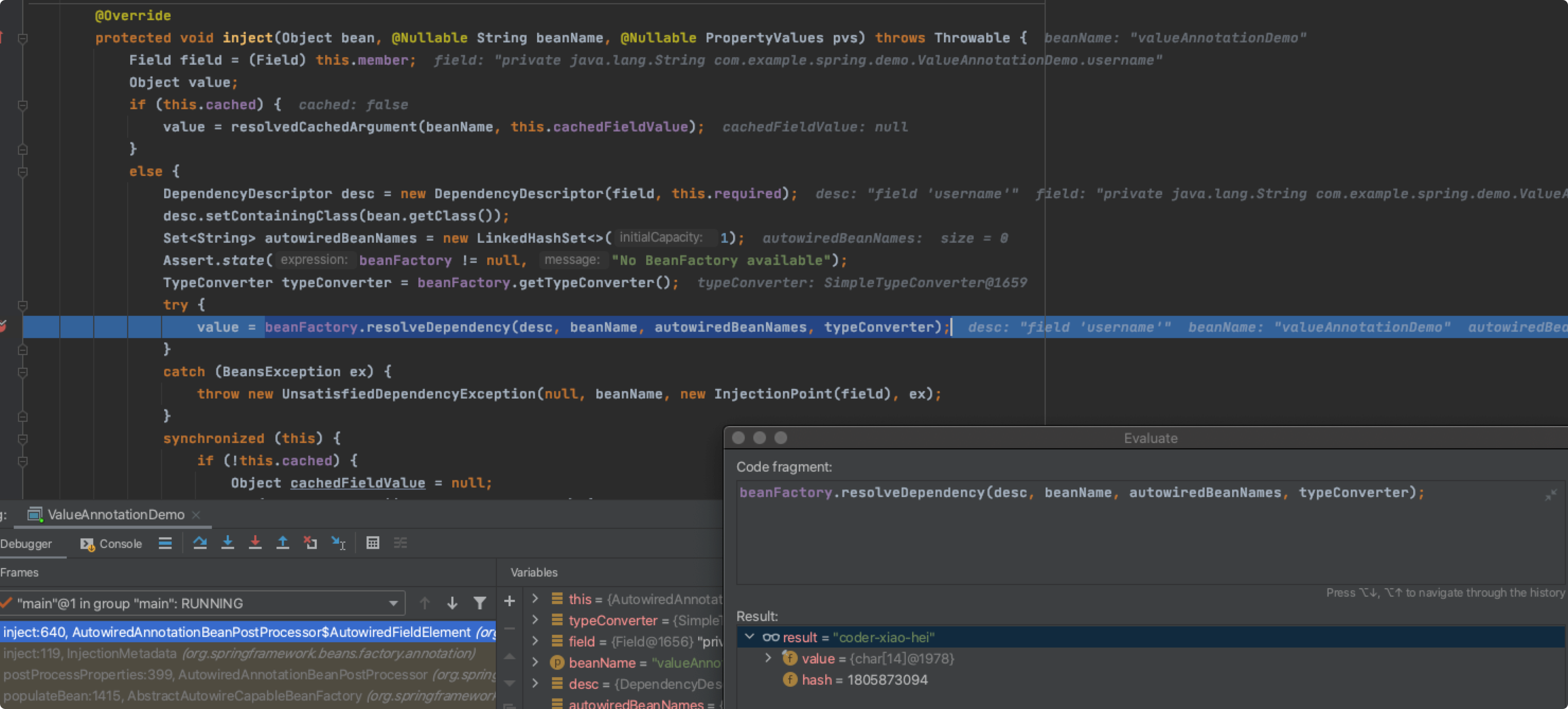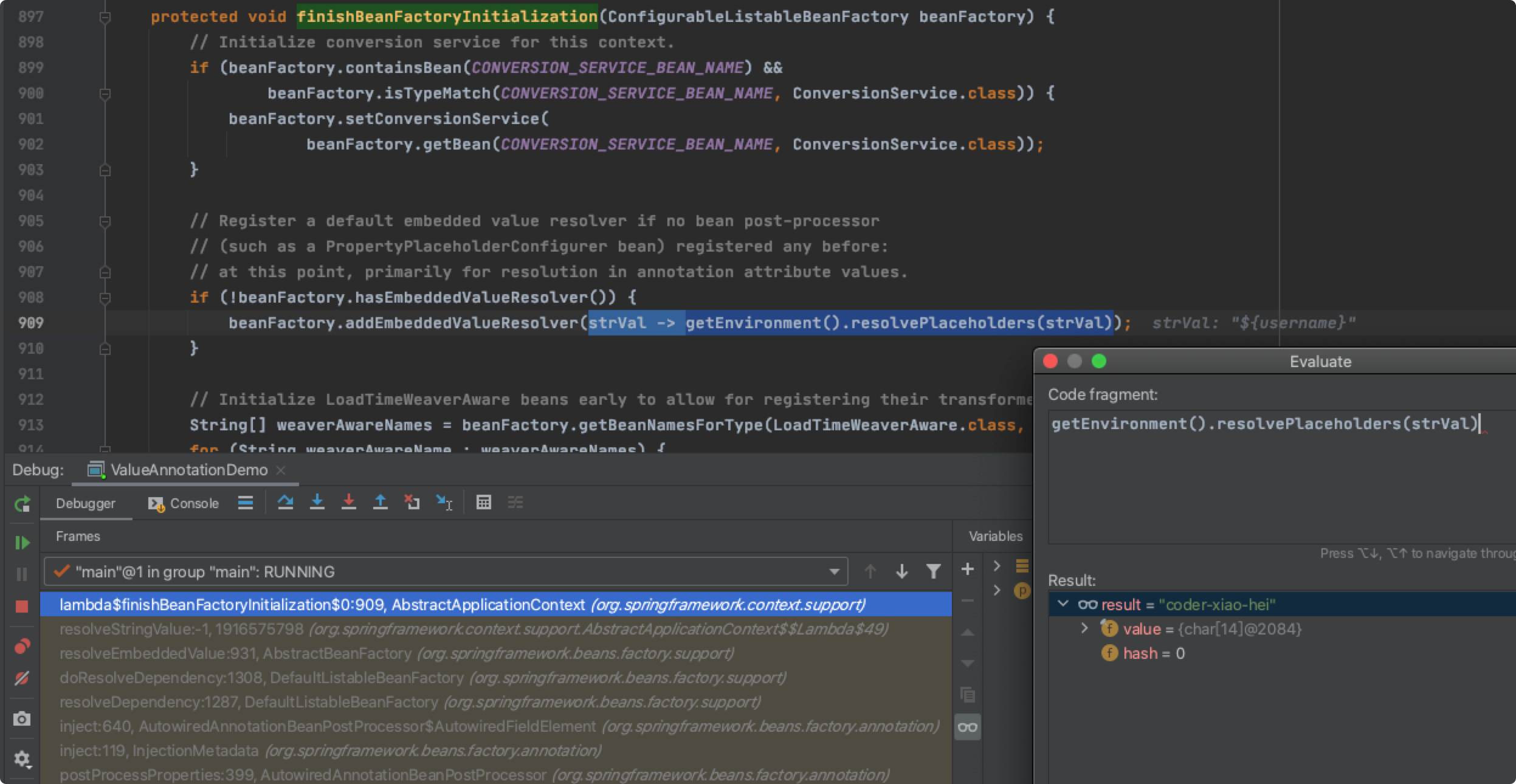hello,大家好,我是小黑,好久不见~~
这是关于配置中心的系列文章,应该会分多篇发布,内容大致包括:
1、Spring 是如何实现 @Value 注入的
2、一个简易版配置中心的关键技术
3、开源主流配置中心相关技术
@Value 注入过程
从一个最简单的程序开始:
@Configuration@PropertySource("classpath:application.properties")public class ValueAnnotationDemo { @Value("${username}") private String username; public static void main(String[] args) { AnnotationConfigApplicationContext context = new AnnotationConfigApplicationContext(ValueAnnotationDemo.class); System.out.println(context.getBean(ValueAnnotationDemo.class).username); context.close(); }}application.properties 文件内容:
username=coder-xiao-hei由 AutowiredAnnotationBeanPostProcessor 负责来处理 @Value ,此外该类还负责处理 @Autowired 和 @Inject。

在 AutowiredAnnotationBeanPostProcessor 中有两个内部类:AutowiredFieldElement 和 AutowiredMethodElement。
当前为 Field 注入,定位到 AutowiredAnnotationBeanPostProcessor.AutowiredFieldElement#inject 方法。

通过 debug 可知,整个调用链如下:
AutowiredFieldElement#injectDefaultListableBeanFactory#resolveDependencyDefaultListableBeanFactory#doResolveDependencyAbstractBeanFactory#resolveEmbeddedValue

通过上述的 debug 跟踪发现可以通过调用 ConfigurableBeanFactory#resolveEmbeddedValue 方法可以获取占位符的值。

这里的 resolver 是一个 lambda表达式,继续 debug 我们可以找到具体的执行方法:

到此,我们简单总结下:
@Value的注入由AutowiredAnnotationBeanPostProcessor来提供支持- 在
AutowiredAnnotationBeanPostProcessor中通过调用ConfigurableBeanFactory#resolveEmbeddedValue来获取占位符具体的值 ConfigurableBeanFactory#resolveEmbeddedValue其实是委托给了ConfigurableEnvironment来实现
Spring Environment
Environment 概述
https://docs.spring.io/spring-framework/docs/current/reference/html/core.html#beans-environment
The Environment interface is an abstraction integrated in the container that models two key aspects of the application environment: profiles and properties.
A profile is a named, logical group of bean definitions to be registered with the container only if the given profile is active. Beans may be assigned to a profile whether defined in
Properties play an important role in almost all applications and may originate from a variety of sources: properties files, JVM system properties, system environment variables, JNDI, servlet context parameters, ad-hoc Properties objects, Map objects, and so on. The role of the Environment object with relation to properties is to provide the user with a convenient service interface for configuring property sources and resolving properties from them.
Environment 是对 profiles 和 properties 的抽象:
- 实现了对属性配置的统一存储,同时 properties 允许有多个来源
- 通过 Environment profiles 来实现条件化装配 Bean
现在我们主要来关注 Environment 对 properties 的支持。
StandardEnvironment
下面,我们就来具体看一下 AbstractApplicationContext#finishBeanFactoryInitialization 中的这个 lambda 表达式。
strVal -> getEnvironment().resolvePlaceholders(strVal)首先,通过 AbstractApplicationContext#getEnvironment 获取到了 ConfigurableEnvironment 的实例对象,这里创建的其实是 StandardEnvironment 实例对象。
在 StandardEnvironment 中,默认添加了两个自定义的属性源,分别是:systemEnvironment 和 systemProperties。

也就是说,@Value 默认是可以注入 system properties 和 system environment 的。
PropertySource
StandardEnvironment 继承了 AbstractEnvironment 。
在 AbstractEnvironment 中的属性配置被存放在 MutablePropertySources 中。同时,属性占位符的数据也来自于此。

MutablePropertySources 中存放了多个 PropertySource ,并且这些 PropertySource 是有顺序的。

PropertySource 是 Spring 对配置属性源的抽象。

name 表示当前属性源的名称。source 存放了当前的属性。
读者可以自行查看一下最简单的基于 Map 的实现:MapPropertySource 。
配置属性源
有两种方式可以进行属性源配置:使用 @PropertySource 注解,或者通过 MutablePropertySources 的 API。例如:
@Configuration@PropertySource("classpath:application.properties")public class ValueAnnotationDemo { @Value("${username}") private String username; public static void main(String[] args) { AnnotationConfigApplicationContext context = new AnnotationConfigApplicationContext(ValueAnnotationDemo.class); Map<String, Object> map = new HashMap<>(); map.put("my.name", "coder小黑"); context.getEnvironment() .getPropertySources() .addFirst(new MapPropertySource("coder-xiaohei-test", map)); }}总结
- Spring 通过
PropertySource来抽象配置属性源,PropertySource允许有多个。MutablePropertySources - 在 Spring 容器启动的时候,会默认加载 systemEnvironment 和 systemProperties。
StandardEnvironment#customizePropertySources - 我们可以通过
@PropertySource注解或者MutablePropertySources API来添加自定义配置属性源 Environment是 Spring 对 profiles 和 properties 的抽象,默认实现是StandardEnvironment@Value的注入由AutowiredAnnotationBeanPostProcessor来提供支持,数据源来自于PropertySource
public class Demo { @Value("${os.name}") // 来自 system properties private String osName; @Value("${user.name}") // 通过 MutablePropertySources API 来注册 private String username; @Value("${os.version}") // 测试先后顺序 private String osVersion; public static void main(String[] args) { AnnotationConfigApplicationContext context = new AnnotationConfigApplicationContext(); context.register(Demo.class); ConfigurableEnvironment environment = context.getEnvironment(); MutablePropertySources propertySources = environment.getPropertySources(); Map<String, Object> source = new HashMap<>(); source.put("user.name", "xiaohei"); source.put("os.version", "version-for-xiaohei"); // 添加自定义 MapPropertySource,且放在第一位 propertySources.addFirst(new MapPropertySource("coder-xiao-hei-test", source)); // 启动容器 context.refresh(); Demo bean = context.getBean(Demo.class); // Mac OS X System.out.println(bean.osName); // xiaohei System.out.println(bean.username); // version-for-xiaohei System.out.println(bean.osVersion); // Mac OS X System.out.println(System.getProperty("os.name")); // 10.15.7 System.out.println(System.getProperty("os.version")); // xiaohei System.out.println(environment.getProperty("user.name")); //xiaohei System.out.println(environment.resolvePlaceholders("${user.name}")); context.close(); }}简易版配置中心
@Value 支持配置中心数据来源
@Value 的值都来源于 PropertySource ,而我们可以通过 API 的方式来向 Spring Environment 中添加自定义的 PropertySource。
在此处,我们选择通过监听 ApplicationEnvironmentPreparedEvent 事件来实现。
@Slf4jpublic class CentralConfigPropertySourceListener implements ApplicationListener<ApplicationEnvironmentPreparedEvent> { private final CentralConfig centralConfig = new CentralConfig(); @Override public void onApplicationEvent(ApplicationEnvironmentPreparedEvent event) { centralConfig.loadCentralConfig(); event.getEnvironment().getPropertySources().addFirst(new CentralConfigPropertySource(centralConfig)); } static class CentralConfig { private volatile Map<String, Object> config = new HashMap<>(); private void loadCentralConfig() { // 模拟从配置中心获取数据 config.put("coder.name", "xiaohei"); config.put("coder.language", "java"); new Thread(() -> { try { TimeUnit.SECONDS.sleep(10); } catch (InterruptedException e) { e.printStackTrace(); } // 模拟配置更新 config.put("coder.language", "java222"); System.out.println("update 'coder.language' success"); }).start(); } } static class CentralConfigPropertySource extends EnumerablePropertySource<CentralConfig> { private static final String PROPERTY_SOURCE_NAME = "centralConfigPropertySource"; public CentralConfigPropertySource(CentralConfig source) { super(PROPERTY_SOURCE_NAME, source); } @Override @Nullable public Object getProperty(String name) { return this.source.config.get(name); } @Override public boolean containsProperty(String name) { return this.source.config.containsKey(name); } @Override public String[] getPropertyNames() { return StringUtils.toStringArray(this.source.config.keySet()); } }}通过 META-INF/spring.factories 文件来注册:
org.springframework.context.ApplicationListener=com.example.config.CentralConfigPropertySourceListener实时发布更新配置
一般来说有两种方案:
客户端拉模式:客户端长轮询服务端,如果服务端数据发生修改,则立即返回给客户端
服务端推模式:发布更新配置之后,由配置中心主动通知各客户端
- 在这里我们选用服务端推模式来进行实现。在集群部署环境下,一旦某个配置中心服务感知到了配置项的变化,就会通过 redis 的 pub/sub 来通知客户端和其他的配置中心服务节点
- 轻量级实现方案,代码简单,但强依赖 redis,pub/sub 可以会有丢失
自定义注解支持动态更新配置
Spring 的 @Value 注入是在 Bean 初始化阶段执行的。在程序运行过程当中,配置项发生了变更, @Value 并不会重新注入。
我们可以通过增强 @Value 或者自定义新的注解来支持动态更新配置。这里小黑选择的是第二种方案,自定义新的注解。
@Target(ElementType.FIELD)@Retention(RetentionPolicy.RUNTIME)@Documentedpublic @interface ConfigValue { String value();}@Componentpublic class ConfigValueAnnotationBeanPostProcessor implements BeanPostProcessor, EnvironmentAware { private static final PropertyPlaceholderHelper PROPERTY_PLACEHOLDER_HELPER = new PropertyPlaceholderHelper( SystemPropertyUtils.PLACEHOLDER_PREFIX, SystemPropertyUtils.PLACEHOLDER_SUFFIX, SystemPropertyUtils.VALUE_SEPARATOR, false); private MultiValueMap<String, ConfigValueHolder> keyHolder = new LinkedMultiValueMap<>(); private Environment environment; @Override public Object postProcessBeforeInitialization(Object bean, String beanName) throws BeansException { ReflectionUtils.doWithFields(bean.getClass(), field -> { ConfigValue annotation = AnnotationUtils.findAnnotation(field, ConfigValue.class); if (annotation == null) { return; } String value = environment.resolvePlaceholders(annotation.value()); ReflectionUtils.makeAccessible(field); ReflectionUtils.setField(field, bean, value); String key = PROPERTY_PLACEHOLDER_HELPER.replacePlaceholders(annotation.value(), placeholderName -> placeholderName); ConfigValueHolder configValueHolder = new ConfigValueHolder(bean, beanName, field, key); keyHolder.add(key, configValueHolder); }); return bean; } /** * 当配置发生了修改 * * @param key 配置项 */ public void update(String key) { List<ConfigValueHolder> configValueHolders = keyHolder.get(key); if (CollectionUtils.isEmpty(configValueHolders)) { return; } String property = environment.getProperty(key); configValueHolders.forEach(holder -> ReflectionUtils.setField(holder.field, holder.bean, property)); } @Override public void setEnvironment(Environment environment) { this.environment = environment; } @AllArgsConstructor static class ConfigValueHolder { final Object bean; final String beanName; final Field field; final String key; }}主测试代码:
@SpringBootApplicationpublic class ConfigApplication { @Value("${coder.name}") String coderName; @ConfigValue("${coder.language}") String language; public static void main(String[] args) throws InterruptedException { ConfigurableApplicationContext context = SpringApplication.run(ConfigApplication.class, args); ConfigApplication bean = context.getBean(ConfigApplication.class); // xiaohei System.out.println(bean.coderName); // java System.out.println(bean.language); ConfigValueAnnotationBeanPostProcessor processor = context.getBean(ConfigValueAnnotationBeanPostProcessor.class); // 模拟配置发生了更新 TimeUnit.SECONDS.sleep(10); processor.update("coder.language"); // java222 System.out.println(bean.language); }}原文转载:http://www.shaoqun.com/a/492941.html
心怡:https://www.ikjzd.com/w/1327
败欧洲网站:https://www.ikjzd.com/w/1555
商标抢注:https://www.ikjzd.com/w/1053
@Value注入如何实现?配置中心关键技术实现思路是?hello,大家好,我是小黑,好久不见~~这是关于配置中心的系列文章,应该会分多篇发布,内容大致包括:1、Spring是如何实现@Value注入的2、一个简易版配置中心的关键技术3、开源主流配置中心相关技术@Value注入过程从一个最简单的程序开始:@Configuration@PropertySource("classpath:ap
hts:hts
promoted:promoted
稻城亚丁冬季 :稻城亚丁冬季
云南有哪些旅游景点?:云南有哪些旅游景点?
口述:老公嫖赌我为他卖房抵债他打我:口述:老公嫖赌我为他卖房抵债他打我